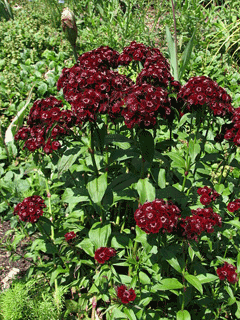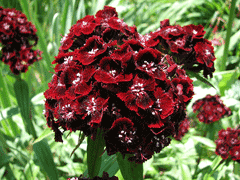 |
|
http://en.wikipedia.org/wiki/User:Ram-Man |
 |
| http://en.wikipedia.org/wiki/User:Ram-Man |
Translate this page:
Summary
Bloom Color: Pink, Red, White.
Main Bloom Time: Early summer, Late summer, Late spring. Form: Upright or erect.
Physical Characteristics

 Dianthus barbatus is a PERENNIAL growing to 0.6 m (2ft) at a medium rate.
Dianthus barbatus is a PERENNIAL growing to 0.6 m (2ft) at a medium rate.
See above for USDA hardiness. It is hardy to UK zone 4 and is not frost tender. It is in flower from July to August, and the seeds ripen from August to September. The species is hermaphrodite (has both male and female organs) and is pollinated by Bees, Lepidoptera (Moths & Butterflies).
It is noted for attracting wildlife.
Suitable for: light (sandy), medium (loamy) and heavy (clay) soils and prefers well-drained soil. Suitable pH: mildly acid, neutral and basic (mildly alkaline) soils. It cannot grow in the shade. It prefers dry or moist soil.
UK Hardiness Map
US Hardiness Map
Synonyms
Plant Habitats
Woodland Garden Sunny Edge; Meadow; Cultivated Beds;
Edible Uses
Edible Parts: Flowers
Edible Uses:
The flowers have a mild flavour and are used as a garnish for vegetable and fruit salads, cakes, desserts, cold drinks etc[183].
References More on Edible Uses
Medicinal Uses
Plants For A Future can not take any responsibility for any adverse effects from the use of plants. Always seek advice from a professional before using a plant medicinally.
None known
References More on Medicinal Uses
The Bookshop: Edible Plant Books
Our Latest books on Perennial Plants For Food Forests and Permaculture Gardens in paperback or digital formats.

Edible Tropical Plants
Food Forest Plants for Hotter Conditions: 250+ Plants For Tropical Food Forests & Permaculture Gardens.
More

Edible Temperate Plants
Plants for Your Food Forest: 500 Plants for Temperate Food Forests & Permaculture Gardens.
More

More Books
PFAF have eight books available in paperback and digital formats. Browse the shop for more information.
Shop Now
Other Uses
References More on Other Uses
Cultivation details
Landscape Uses:Border, Container, Rock garden, Seashore, Specimen. Prefers a rich well-drained loamy soil in a sunny position, but succeeds in most soils including dry ones[1]. A very ornamental plant[1], its flowers are very attractive to butterflies and moths[17, 30]. The flowers have a strong clove-like scent[245]. Plants self-sow freely when grown in a suitable position[1]. Although the Sweet William is a perennial species, it is quite short-lived and degenerates after its second year. It is best treated as a biennial in the garden[200]. Special Features:Attracts butterflies, Suitable for cut flowers, Suitable for dried flowers, Fragrant flowers.
References Carbon Farming Information and Carbon Sequestration Information
Temperature Converter
Type a value in the Celsius field to convert the value to Fahrenheit:
Fahrenheit:
The PFAF Bookshop
Plants For A Future have a number of books available in paperback and digital form. Book titles include Edible Plants, Edible Perennials, Edible Trees,Edible Shrubs, Woodland Gardening, and Temperate Food Forest Plants. Our new book is Food Forest Plants For Hotter Conditions (Tropical and Sub-Tropical).
Shop Now
Plant Propagation
Seed - sow May/June in a cold frame. The seed usually germinates in 2 - 3 weeks. When they are large enough to handle, prick the seedlings out into individual pots and plant them out in the summer or autumn[1]. The seed can also be sown thinly in an outdoor seedbed in late spring, the young plants being planted out in late spring or the autumn. Cuttings of half-ripe shoots, July in a frame[1]. Division in September[1]. Larger clumps can be replanted direct into their permanent positions, though it is best to pot up smaller clumps and grow them on in a cold frame until they are rooting well. Plant them out in the spring.
Other Names
If available other names are mentioned here
Native Range
TEMPERATE ASIA: Russian Federation (Primorye), China (Jilin Sheng (east & south)), Korea, North EUROPE: Austria (south), Hungary (west), Poland (southeast), Slovakia (east), Ukraine (west), Bulgaria, Bosnia and Herzegovina, Croatia, Italy, North Macedonia, Montenegro, Romania, Serbia, Slovenia, Turkey (Kirklareli), Andorra, Spain (northeast), France (south)
Weed Potential
Right plant wrong place. We are currently updating this section.
Please note that a plant may be invasive in one area but may not in your area so it's worth checking.
Conservation Status
IUCN Red List of Threatened Plants Status :

Growth: S = slow M = medium F = fast. Soil: L = light (sandy) M = medium H = heavy (clay). pH: A = acid N = neutral B = basic (alkaline). Shade: F = full shade S = semi-shade N = no shade. Moisture: D = dry M = Moist We = wet Wa = water.
Now available:
Food Forest Plants for Mediterranean Conditions
350+ Perennial Plants For Mediterranean and Drier Food Forests and Permaculture Gardens.
[Paperback and eBook]
This is the third in Plants For A Future's series of plant guides for food forests tailored to
specific climate zones. Following volumes on temperate and tropical ecosystems, this book focuses
on species suited to Mediterranean conditions—regions with hot, dry summers and cool, wet winters,
often facing the added challenge of climate change.
Read More
Expert comment
Author
L.
Botanical References
45200
Links / References
For a list of references used on this page please go here
Readers comment